
Lab Contributes to Latest Global Warming Report
Summer Lecture Series Kicks Off in June
Lab Contributes to Latest Global Warming Report
Bangkok, Thailand: On May 2, two days before the Intergovernmental Panel on Climate Change (IPCC) was scheduled to release a much-anticipated report that outlines ways in which the world can curb global warming, Mark Levine was approached by Belgian delegates. Their government wanted to include a section in the document that outlines how changes in lifestyle, such as car usage and consumer choices, can mitigate climate change — and they asked Levine to write the section.
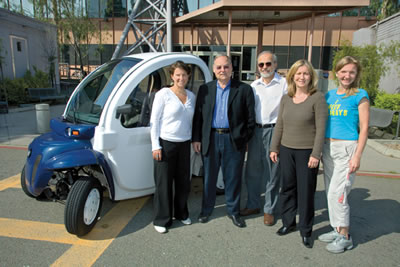
From left to right, Stephane de la Rue du Can, Mark Levine, Jayant Sathaye, Lynn Price, and Aleksandra Novikova next to one of the Lab’s electric cars. photo by roy kaltschmidt, CSO
Levine, an Environmental Energy Technologies Division (EETD) scientist, was in Bangkok along with fellow EETD scientist Jayant Sathaye and dozens of researchers from around the world. Their goal was to draft a 36-page document that summarizes for the world’s policymakers a much longer IPCC report, entitled Climate Change 2007: Mitigation of Climate Change, which is slated to be issued this summer.
Drafting IPCC report summaries is an exhausting process, made all the more demanding by last-minute requests such as the one Levine fielded. With 48 hours to go, he met with the Belgian delegates over lunch and began drafting the section. Sathaye took over later that evening and worked on it until 2 a.m. The next day, one day before the summary was to be released, Levine and Sathaye finalized the section and submitted it to the delegates.
“It was hard work, but that section wouldn’t be in the summary if we hadn’t been there,” says Levine.
Levine and Sathaye aren’t the only Berkeley Lab scientists who put in long hours in advance of the latest IPCC report, a summary of which was issued on May 4 amid worldwide headlines. In fact, they’re among four Berkeley Lab scientists who are listed as authors: Levine is the coordinating lead author of the report’s residential/commercial chapter, Sathaye is the coordinating lead author of the sustainable development and mitigation chapter, and EETD’s Lynn Price and Ernst Worrell are lead authors of the industry chapter.
In addition, EETD research associate Stephane de la Rue du Can and EETD guest researcher Aleksandra Novikova provided key analytical support. And former Lab scientist Willy Makundi, now working in Tanzania, is a lead author of a chapter that explores global warming mitigation strategies in a long-term context.
It’s no coincidence that Berkeley Lab is well represented among the report’s hundreds of authors. The document sketches out a game plan for derailing climate change that relies heavily on utilizing energy efficiency technologies and policies, a field the Lab has been pioneering since the early 1970s. For example, the report targets buildings as having the potential to yield big dividends in reducing greenhouse gas emissions.
“We’ve been the leader in building energy efficiency R&D and analysis in the U.S., if not the world, so we’ve been tapped for IPCC reports when they include building energy efficiency,” says Levine, who has helped author such reports for the past 15 years.
The IPCC was established under the auspices of the United Nations to study climate change, its potential impacts, and options for mitigation. The panel issues a series of reports about every six years that provides an up-to-date assessment of the current state of knowledge on climate change.
Earlier this year, as part of its fourth assessment entitled Climate Change 2007, the IPCC issued two reports that paint a grim picture of the future. The first report, released in February, determined that global temperatures would likely rise by 1.8°C to 4.0°C, and possibly by 6.4°C under the worst-case scenario, over the next century. A second report issued in April linked global warming with the extinction of up to 30 percent of the planet’s animal and plant life.
The third and most recent May 4 report, however, offers an upbeat note. It concludes that the global community can prevent the devastating impacts of climate change, provided it acts soon. Importantly, this is achievable through currently available strategies such as utilizing alternative energy sources and energy efficiency technologies, reducing deforestation, and implementing sound policies and economic incentives.
“There isn’t a silver bullet,” says Lynn Price. “There are hundreds of technologies available now, with others in the process of commercialization or in the R&D phase. We need to pursue a portfolio of options.”
Price, along with Ernst Worrell, analyzed scientific literature published since the last assessment report was issued in 2001. They sought to determine what works and what doesn’t work when it comes to mitigating greenhouse gas emissions in energy-intensive industries such as steel, aluminum, cement, chemical, and paper manufacturing, as well as petroleum refining.
Stabilizing climate change will also require policies that promote sustainable development, according to Jayant Sathaye. As an example, he points to the need to reduce deforestation, which contributes to about 15 percent of the planet’s total emissions of carbon dioxide.
“But stopping deforestation is not easy because it supports local economies and timber companies in developing nations,” says Sathaye, whose involvement in drafting IPCC reports dates back to 1990. “There needs to be mechanisms and policies that encourage nations to slow deforestation.”
Ultimately, the report concludes that all sectors — energy supply, transportation, buildings, industry, agriculture, waste management, and forestry — will have to make contributions.
“They’re all significant, and we will need them all in order to stabilize the climate,” says Levine, who adds that mitigating climate change won’t be easy, but it is possible. “This is extremely difficult. We’re talking about changing a whole way of economic life and spending a lot of money doing it. But I left the meeting more optimistic than when I arrived. This report gives the sense that it’s not impossible.”
Summer Lecture Series Kicks Off in June
Want to have lunch with someone at the forefront of science? You can, thanks to the 2007 Berkeley Lab summer lecture series, which kicks off June 20. These illuminating talks take place Wednesdays at noon in the Building 50 auditorium. The lectures are designed for Lab staff, visiting students and teachers, and anyone who is curious about cutting-edge research explained in everyday language. Bring a bag lunch and questions.
June 20
Chris Somerville: Development of Cellulosic Biofuels
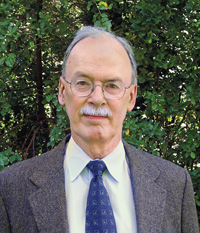
Sommerville
Chris Somerville is a new addition to the Physical Biosciences Division who played a key role in procuring the BP grant for the Energy Biosciences Institute. He is a leading authority on the structure and function of plant cell walls, and an award-winning plant biochemist who directs the Carnegie Institution’s Department of Plant Biology, a non-profit scientific research organization located at Stanford University. His lecture will present an overview of some of the technical challenges associated with the production of cellulosic biofuels, which will require an improved understanding of a diverse range of topics in fields such as agronomy, chemical engineering, microbiology, structural biology, genomics, environmental sciences, and socioeconomics.
June 27
Trudy Forte: Stealth Particles for Targeted Delivery of Drugs to Brain Tumors
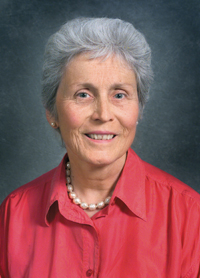
Forte
Trudy Forte of the Life Sciences Division will discuss her work developing nano-sized low-density lipoprotein (LDL) particles that can be used as a safe and effective means of delivering anticancer drugs to brain tumors, particularly glioblastoma multiforme. This is the most common malignant brain tumor in adults and one of the deadliest forms of cancer. Her research team found that the synthetic LDL particles can target and kill such tumors cells in vitro. The nanoparticles are composed of a lipid core surrounded by a peptide. The peptide contains an amino acid sequence that recognizes the LDL receptor, and the lipid core has the ability to accumulate anti-cancer drugs.
July 11
Bill Collins: The Future of the Earth’s Climate: Frontiers in Forecasting

Collins
Leading climate modeler Bill Collins joined the Earth Sciences Division in April to form a new department dedicated to atmospheric and climate science. Collins is also teaching at UC Berkeley’s Department of Earth and Planetary Science. At Berkeley Lab, he heads an initiative to create a new kind of climate model that integrates cutting-edge climate science. He’ll discuss how observations show that the Earth is warming at a rate unprecedented in recent history, and that human-induced changes in atmospheric chemistry are probably the main culprits. Climate models suggest that patterns of global warming will amplify over the 21st century, impacting plants, animals, and society. Improvements in the scientific foundation of climate forecasts will require better observations and understanding of the carbon and hydrological cycles.
July 18
Terry Hazen: Bioremediation: The Hope and the Hype for Environmental Cleanup
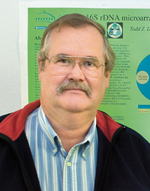
Hazen
Terry Hazen of the Earth Sciences Division is a leading authority on bioremediation, which uses biological processes to clean up toxic and non-toxic compounds. He will discuss when it’s best to resort to engineered bioremediation of contaminated sites, and when it’s best to rely on natural attenuation. Recent advances in systems biology, ecogenomics, and synthetic biology have greatly broadened the potential applications for bioremediation in cleaning up many types of contamination. At the same time, however, scientists’ knowledge of biogeochemical processes has advanced to such an extent that they can better gauge how quickly and completely contaminants can be degraded without human intervention.
July 25
Michael Barnett: The ATLAS Experiment: Mapping the Secrets of the Universe
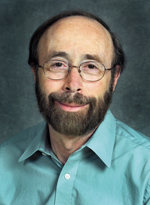
Barnett
Michael Barnett of the Physics Division will discuss the ATLAS Experiment at the European Laboratory for Particle Physics’ (CERN) Large Hadron Collider. The collider will explore the aftermath of collisions at the highest energy ever produced in the lab, and will recreate the conditions of the universe a billionth of a second after the Big Bang. The ATLAS detector is half the size of the Notre Dame Cathedral and required 2000 physicists and engineers from 35 countries for its construction. Its goals are to examine mini-black holes, identify dark matter, understand antimatter, search for extra dimensions of space, and learn about the fundamental forces that have shaped the universe since the beginning of time and will determine its fate.
ALS Employee Descendant of Civil Rights Pioneer
When Valerie Wysinger, an administrator at the Advanced Light Source, gathers with 100 or so other relatives from around the State for a Wysinger family reunion, they do more than share food and family gossip. They celebrate a proud legacy to which few other families could lay claim.
It was Wysinger’s great-great-grandfather, Edmond Wysinger, who in 1890 successfully led the challenge to desegregate California’s schools, stamping the family name indelibly on the history of civil rights law in America.
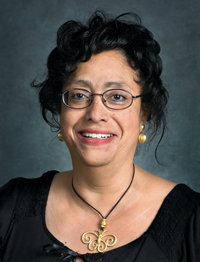 Valerie Wysinger
Valerie Wysinger
Edmond Wysinger came to California as a slave with his German owner with one purpose: to mine for gold. They made the journey by covered wagon through treacherous Donner Pass, arriving in 1849, at the height of the Gold Rush. Like many of the more than 5,000 black miners who had come west to escape slavery, Wysinger was eventually able to buy his freedom, then priced at approximately $1,000, using money he earned working in the mines.
In fact, Edmond earned enough money, Valerie Wysinger says, to buy a large farm on the outskirts of Fresno, where he settled with his wife, Pernesa, and raised 8 children — six sons and two daughters. It was Edmond’s attempt to enroll one of those sons, 12-year-old Arthur, in Visalia High School that began his historic legal battle. Arthur was refused entry to the school solely because of his race.
On Oct. 2, 1888, Wysinger filed a writ of mandate on behalf of Arthur, challenging a public institution’s authority to deny a group its constitutional right because of race, color, or national origin. On Jan. 29, 1890, the California Supreme Court, in the landmark case Wysinger v. Crookshank, ruled that public school districts in California may not establish separate schools for children of African descent or exclude them from public schools established for white children, and ordered Arthur to be admitted. Arthur became the first African American ever to graduate from public high school in Visalia. Thereafter, the Supreme Court’s decision made it possible for Native American and African American children to attend any public school in their districts in California.
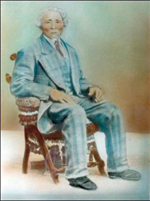
Wysinger's great- great-grandfather Edmond
The family members descended from Edmond have spread out across the state now, many of them, like Valerie, settling in the Bay Area. Three of his descendants, Valerie, Myra Wysinger, and Lavonne Rochon, have carried on the educational legacy of their great-great-grandfather, working at the University of California. Myra contributed to a historical website detailing the famous case.
What does it feel like to carry such a weighty family history? Valerie speaks proudly of her great, great grandfather’s accomplishments, but laughs about her experiences on the Wysinger farm, a part of which remains in family ownership to this day. When Valerie was in the 7th grade, her father Virgil moved the family from their home in Seattle, WA back to the farm when no one else was able to run it, trying his hand at growing asparagus.
“I was not too happy about that,” Valerie joked, ”and as soon as I graduated from high school I made my way to the Bay Area.” But, says Valerie, her mother Melba, now 78, still lives on the farm, on that little piece of freedom's history.
Facilities Staffer Uses Humor, Creativity to Share Safety Tips
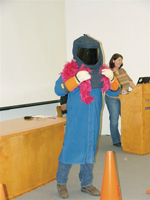
Electric Shop Supervisor Jim Murphy struts at Safety Fashion Show
photo by roy kaltschmidt, CSO
Ever wonder who puts together those entertaining safety posters displayed on various bulletin boards around the Lab?
One featured the Beatles’ Abby Road album cover with the heads of facility workers replacing John, Paul, George and Ringo. Another had two painters disco dancing alongside John Travolta ala Saturday Night Fever.
The brainchild behind these and other creative efforts to help reduce accidents at the Lab is Facilities Division Safety Coordinator Janice Sexson.
Her chuckle-inducing endeavors began shortly after joining “Workers Observing Workers” (WOW) in 1998. Sexon was attracted to this peer safety program because of the high value they placed on communicating safety messages.

Sexson
“I was thinking there had to be another avenue, besides memos and lectures, to get information out,” Sexson recalls. “Using humor seemed like a good way to get people’s attention and make the lessons stick.”
An artistic person by nature, it was easy for Sexson to dream up various scenarios for posters, using pop culture icons and Photoshop computer software to fashion hilarious scenarios.
For example, in one poster she showed the accident-prone Mr. Bill character from Saturday Night Live suffering an electrical accident, then receiving CPR from a Lab fireman and a stern lecture from then Division Director Bob Camper. Other themes have included American “Safety” Idol, a film noir tribute, and a conscience duel between an angel and devil.

Her safety messages are not limited to posters. She, along with a team of WOW members and other Facilities staff, organized a Personal Protective Equipment fashion show in the Building 50 Auditorium, in which supervisors modeled proper safety gear. “Some audience members were laughing so hard they were crying,” says Sexson.
And last year, the first-ever Halloween Haunted Laboratory was held in Perseverance Hall. One area showed the ‘gruesome’ consequences of not seeking medical services in a timely fashion, while another displayed the “horror” of a non-ergonomic workstation.
“It’s a lot of hard work, but putting the events and posters together is really enjoyable,” says Sexson. “It’s a way to step out of my normal duties and indulge my creative side while providing a service to the Lab.”
Berkeley Lab View
Published once a month by the Communications Department for the employees and retirees of Berkeley Lab.
Reid Edwards, Public Affairs Department head
Ron Kolb, Communications Department head
EDITOR
Pamela Patterson, 486-4045, pjpatterson@lbl.gov
Associate editor
Lyn Hunter, 486-4698, lhunter@lbl.gov
STAFF WRITERS
Dan Krotz, 486-4019
Paul Preuss, 486-6249
Lynn Yarris, 486-5375
CONTRIBUTING WRITERS
Ucilia Wang, 495-2402
Allan Chen, 486-4210
David Gilbert, (925) 296-5643
DESIGN
Caitlin Youngquist, 486-4020
Creative Services Office
Berkeley Lab
Communications Department
MS 65, One Cyclotron Road, Berkeley CA 94720
(510) 486-5771
Fax: (510) 486-6641
Berkeley Lab is managed by the University of California for the U.S. Department of Energy.
Online Version
The full text and photographs of each edition of The View, as well as the Currents archive going back to 1994, are published online on the Berkeley Lab website under “Publications” in the A-Z Index. The site allows users to do searches of past articles.
Flea Market is now online at www.lbl.gov/fleamarket
Novel System Helps Lab Run Smoothly
Ken Fletcher of Berkeley Lab’s Facilities Division is scheduled to give a talk via web conference to members of the CIA in a few weeks. The subject isn’t top secret. In fact, it seems a little mundane given the audience: how to create an integrated facilities assessment, planning, and reporting system.
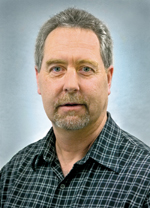 Ken Fletcher
Ken Fletcher
Fletcher has given this talk at several conferences over the past few years, and facility managers from a number of DOE facilities have visited the Lab to pick his brain. Even the U.S. Coast Guard has dropped by. Why so much interest? It turns out that the Lab’s Facilities Division has developed an innovative method to comprehensively manage the upkeep of its infrastructure, which encompasses everything from the most expansive strategic maintenance plan to the smallest project, like fixing a door.
It all started four years ago, when the Lab sought to integrate the strategic side of facilities management — assessing the condition of its infrastructure — with the more day-to-day aspect of management, which involves tracking the myriad projects that keep that infrastructure operating smoothly.
“We needed a system that not only encompassed conducting assessments, estimating requirements, and analyzing what buildings to focus on, but also took it a step further and developed work projects and went into the execution phase,” says Fletcher. “But there wasn’t any software available that allowed us to do this in an integrated way.”
So, being maintenance engineers, they found two unrelated commercial software packages that together fit the bill — and melded them into one system. Specifically, in 2004, the Facilities Division began to develop the Integrated Facilities Condition Management System. Fletcher, Steve Black, and Bruce Anderson have been instrumental in developing the system, which merges a software program from VFA Facilities, which offers strategic facilities maintenance planning, with another program from MRO Maximo, which offers a daily work management system.
“These companies are very good at what they do, so we combined their products,” says Fletcher. “We worked with both companies and got them to share common data elements in their software.”
The result is a management tool for the Lab’s buildings, roads, walkways, retaining walls, storm drains, and underground utilities. It enables members of the Facilities Division to capture the Lab’s infrastructure condition in one central data repository, and use the data to conduct long-term strategic planning. Importantly, managers can use the information to track and control individual work projects. And when a project is completed, the system allows Facilities personnel to compare the actual cost with the estimated cost.
“It’s not just software, we’ve built a complex and effective business process around it,” says Fletcher. “It allows us to allocate maintenance funds to best meet the scientific objectives of the Lab.”
The system met with success soon after the Lab rolled it out. Berkeley Lab was recognized by the Department of Energy in 2004 for developing a best practice integrated facilities management solution. And it’s still a work in progress. The Facilities Division is working to take the information gathered by the system and automatically feed it into DOE’s facilities database, the Facilities Information Management System. The ultimate goal is to help the Lab meet its objective of performing world-class science.
“We are engaged in what’s important to the Lab, and we can change very quickly depending on its priorities,” says Fletcher. “Science changes so quickly, and we have to be able to change with it.”
Ready for an Emergency? Lab’s Preparedness Week Will Help
Emergencies come in all shapes and sizes – earthquakes, fires, weather catastrophes, pandemics, etc. They are hard – if not impossible — to predict, so it’s difficult to get motivated to plan for something that may not happen. But the old Boy Scout pledge of “Be Prepared” still rings true.

Think New Orleans. Think Loma Prieta. Think the Oakland Hills. Lessons about preparing yourself and your family for surviving the unexpected disaster have never been more graphically taught than in those three events. Berkeley Lab’s Security and Emergency Operations (SEO) office exists to prepare the Laboratory to respond effectively to the unexpected, and its personnel would like to share their knowledge with the Lab community.
Hence the first “Emergency Preparedness Week” at Berkeley Lab, June 4-8.
Through the information provided at preparedness and wellness fairs, demonstrations, a Lab-wide earthquake evacuation drill, and special talks, the Lab’s emergency team hopes to raise awareness and motivate behavior toward maintaining personal and family safety and health.
“It also gives us an opportunity to let Lab employees know what services are available to them, and what mechanisms we have in place to ensure their safety and security,” said SEO manager Rocky Sanders.
The week kicks off with an information fair on Monday, June 4, from 11:30 a.m. to 1:30 p.m. at the cafeteria that will include displays and take-away handouts. Among those sharing preparedness hints will be the Alameda County Fire Department – contractor to Berkeley Lab for fire services – the Lab’s amateur radio group, the SEO program, “Supplies and Solutions” industrial service providers, and regional vendors. The Network for Earthquake Engineering Simulation will demonstrate a shake table, which simulates quakes at various strengths; Lab Medical Services will staff an emergency tent; and SEO will offer tastings of emergency freeze-dried food.
As for real food, the Lab cafeteria will be offering an outdoor barbecue special, featuring a sandwich, chips and a soda for $5. Facilities’ George Rosas will provide recorded music for the occasion, and political representatives will pay tribute to the Lab in a brief program at 12:15 p.m. on the cafeteria lawn stage. And there will be a raffle for attendees to win personal emergency kits and supplies donated by the vendors.
Three days later, on June 7, the Summer Wellness Fair takes over the cafeteria lawn space from 11:30 a.m.-1:30 p.m. It will include a barbecue lunch, a Farmer’s Market, music, free chair massage and blood pressure checks, and an assortment of vendors. These include all UC-sponsored health care representatives, plus Fidelity, Onside Dental, Cal State 9 Credit Union, A-Plus Insurance, and 24-Hour Fitness.
The centerpiece of Preparedness Week will be the annual drop-cover-and-hold earthquake drill, set for June 6 at 10:30 a.m. All buildings will be evacuated, and the Lab’s Emergency Operations Center will conduct a response-and-recovery exercise.
Two noted speakers will present topical talks at noon on Thursday and Friday, June 7 and 8, in the Building 50 Auditorium. On Thursday, Ana-Marie Jones, executive director of the Collaborating Agencies Responding to Disasters (CARD), will speak on “Prepare to Prosper! A New Approach to Personal Preparedness.” And on Friday, David P. Schwartz, earthquake geologist from the U.S. Geological Survey, will discuss the Bay Area’s earthquake threat and the next “big one.” Both talks will be preceded by a 10-minute film about the Berkeley Hills fire of 1991, entitled “May I Have Your Attention.”
On Tuesday, June 5, a helicopter from California Shock Trauma Air Rescue will fly into the Lab to demonstrate the capabilities of such an ambulance service in case of emergencies. The copter is scheduled to land at noon and stay for an hour for visits in the Building 51 (Bevatron) parking lot.
Emergency Preparedness Week (June 4-8)
- Monday: Information Fair, 11:30 a.m. to 1:30 p.m., cafeteria
- Tuesday: California Shock Trauma Helicopter landing, noon, Bldg. 51 lot
- Wednesday: Drop, Cover, and Hold Earthquake Drill, 10:30 a.m.
- Thursday: Summer Wellness Fair, 11:30 a.m. to 1:30 p.m., cafeteria
- “New Approach to Preparedness” lecture, noon, Bldg. 50 Auditorium
- Friday: “Bay Area Earthquakes” lecture, noon, Bldg. 50 Auditorium
An Astronomical Journey to Eastern Africa
‘Hands-On’ Universe Holds Cyber Workshop for Kenyan Teachers
For high school students in the Republic of Kenya in Eastern Africa, star-gazing is about to get a serious upgrade. Coming to Kenya this spring is Hands-On-Universe (HOU), the international award-winning educational program, funded by the National Science Foundation, that teaches astronomy, math and science to primary and secondary level school students by bringing them professional grade telescopic images of the universe. On May 10 and 11, HOU held an Internet teleconference workshop for nearly a dozen teachers at Kenya High School, a national residency school for girls. This was the first HOU workshop ever held on the continent of Africa.
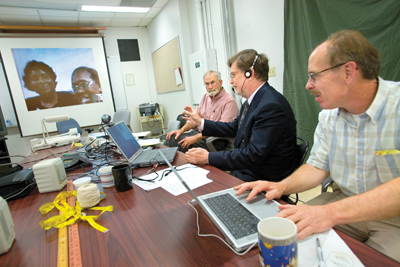 Lohman, left, Smoot, center, and Pennypacker anchored the Berkeley Lab end of a Hands-On Universe workshop for Kenya High School teachers
Lohman, left, Smoot, center, and Pennypacker anchored the Berkeley Lab end of a Hands-On Universe workshop for Kenya High School teachers
“The HOU teachers’ workshop in Kenya is an opportunity to bring to African students the wonder and excitement of astronomy. HOU motivates young people to learn more about astronomy and related scientific and technical topics, and enables them to develop skills that will help them succeed in a modern society,” said Berkeley Lab astrophysicist and Nobel Laureate George Smoot.
HOU, which began at Berkeley Lab and is now under the Lawrence Hall of Science, will soon be headquartered at a cosmology educational center being established by Smoot.
HOU was started by Carl Pennypacker, an astrophysicist and Smoot colleague at Berkeley Lab in the early 1990s when he began providing high school students with star images from the Leuschner Obser-vatory of the University of Califor-nia at Berkeley. The students used these images to make actual cosmology discoveries, including asteroids and the first light of a supernova. Pennypacker has since expanded the program so that today, HOU reaches more than 1,500 classrooms across the world.
“HOU has been tested in more than 18 nations over the last decade. It is based on a number of successful educational technologies, and easily holds the potential to reach millions of young people and a hundred thousand primary and secondary level teachers,” said Pennypacker. “HOU students are excited and inspired about the universe and their engagement in challenging subjects can advance all society. With the HOU program, we’re confident we can reach our audience in a sustainable way with powerful, inspiring and engaging science education. Our current goal is to reach 100 nations within five years or so.”
 Hands-On Universe volunteer Murabama, right, with Kenya High School student
Hands-On Universe volunteer Murabama, right, with Kenya High School student
HOU’s inaugural event at Kenya High School was organized by Pennypacker and Susan Murabana, a computer programmer in Nairobi, who is currently studying astronomy at James Cook University in Australia. Murabana became involved with HOU through Hakeem Oluseyi, a former colleague of Pennypacker’s at Berkeley Lab, who is now an astrophysicist at the Florida Institute of Technology. Today, Murabana and Oluseyi are working closely with Pennypacker to bring HOU to Africa.
“I have been working as a CE volunteer for the past five years to promote science education in sub-Saharan nations, visiting schools and engaging students, and meeting with community and political leaders in South Africa, Swaziland, Botswana, Zambia, Tanzania, Uganda, Ghana and Kenya,” said Murabana. “My main reason for picking Kenya High School is that it as a national school for girls, it has girls from all over the country. Our goal is to use Kenya High as an HOU training ground which will allow us to invite other schools with fewer facilities into the program.”
Added Oluseyi, “The educational level and the technological infrastructure level in Nairobi (Kenya’s capital and one of Africa’s largest and most prominent cities) are appropriate for a project like HOU. Nairobi classrooms are ready for the introduction of research methodologies in the cutting edge sciences while working with real data that HOU provides.”
Kenya High has three computer labs with a total of 70 computers that are all networked to a server. While the school does not have Internet access, the UUNET hosting center in Kenya agreed to provide free Internet service for the workshop. The HOU Kenya High teachers’ workshop was teleconferenced from out of Berkeley Lab via SightSpeed, Inc., a free Internet video and voice communications services provider based in Berkeley.
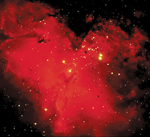 This image of M16, the Eagle Nebula, was taken by a team of HOU teachers using the NOAO Kitt Peak National Observatory in southern Arizona. This is an example of the images teachers and students can obtain in their own classrooms through the HOU program
This image of M16, the Eagle Nebula, was taken by a team of HOU teachers using the NOAO Kitt Peak National Observatory in southern Arizona. This is an example of the images teachers and students can obtain in their own classrooms through the HOU program
Running the program was Rich Lohman, a veteran high school science teacher and HOU trainer, with assistance from Pennypacker. The program included a combination of powerpoint lectures and computer activities using HOU software and astronomical images, plus an assortment of supplemental exercises. Among other things, teachers learned how to measure size and distance in space, how to track objects as they move across the sky, and how to plot a supernova light curve.
“The Kenya High workshop opened up some excellent possibilities for international cooperation and contact, and brought technology and training to the Kenya teachers,” Lohman said. “For example, in one exercise we had teachers use HOU software tools to determine the period and orbital radius of one of Jupiter’s moons, Io. With that information they then calculated the mass of Jupiter itself.”
Completion of the HOU teachers’ workshop was a crucial first step to bringing African schools into the global network of research-based science educational programs. Pennypacker, Oluseyi and Murabana are already working on an agreement with the British Council to give Kenyan teachers and their students future access to images from the powerful 2-meter Faulkes Telescope on Haleakela, Hawaii. The Faulkes Telescope is the cornerstone of Las Cumbres Observatory Global Telescope Network, which operates research class robotic telescopes in Hawaii and Australia.
Said Murabana, “The students in Kenya are ready to be taken to the next level. The introduction of HOU into Kenya facilitates this step.”
Lab Fiber Optics Used to Sync Laser at Quadrillionth of a Second
“In the new generation of accelerators, all components and experiments have to be timed relative to one another within femtoseconds” — quadrillionths of a second — “by means of a master clock,” says John Staples, of the Accelerator and Fusion Research Division’s Center for Beam Physics.
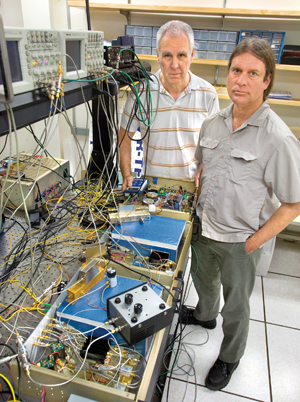 Staples, left, and Wilcox
Staples, left, and Wilcox
photo by roy kaltschmidt, CSO
While femtosecond lasers have been around since the 1980s, “typically a laser experiment sits on a table top, so travel times are short and the different components are not hard to synchronize,” says Russell Wilcox of the Engineering Division, Staples’s colleague in designing an accelerator timing system. “A two-kilometer-long accelerator is another problem altogether.”
Staples and Wilcox use a near-infrared laser as their clock, sending its light through high-quality optical fiber. Continually tuning the beam to the absorption line of acetylene in a gas cell keeps the frequency accurate. Unfortunately temperature changes and noise affect signal velocity through the fiber and throw timing off.
When lightwaves are reflected back through the fiber, however, they interfere to produce interference fringes. Changes of transit time change the number of fringes per unit length, “So we monitor the number of fringes and add or subtract length to maintain the right number,” Staples says.
Two kinds of compensating mechanisms do the job. In one, a wrapped piezoelectric core quickly responds to changes in an electric field, stretching the fiber. The other, a variable air gap, is slower but makes bigger changes. Light leaves the fiber and travels through open air for few millimeters, strikes a mirror, and is reflected back into the continuing fiber.
To test the system, Staples says, “We needed a real-world environment. What better place than a couple of kilometers of fiber optics running around Berkeley Lab, under roads, in and out of buildings and communications closets? We called up Ted Sopher and Ed Ritenour in the Information Technology Division and asked, ‘Do you have an extra loop of fiber a couple of kilometers long?’“
Ritenour and Sopher identified a loop of high-speed fiber optics cable from Building 71, where Staples and Wilcox’s lab is located, to Building 10, adjacent to the ALS, and back, a round-trip distance of 1.97 kilometers. They helped Staples and Wilcox connect to the nearest terminal.
“We send the light out on the fiber and it returns to our lab 1.97 kilometers later,” Staples says. The reflected light then goes out and back again, for a total path length of 3.94 kilometers. “We analyze the light upon its return and impose the corrections needed to stabilize it.”
In the finished system, a group of fibers will go from the master clock to separate experiments and accelerator components. Says Staples, “the client at the end of each fiber will be in femtosecond-level synchronism with all the others.”
The first customer for the fiber-optics based femtosecond timing system is SLAC’s Linac Coherent Light Source. Other potential users include the FERMI free-electron laser (FEL) facility at the Elettra synchrotron in Trieste, Italy; the proposed International Linear Collider; and, not least, the Lab’s own planned “FEL Farm,” a linac that will power 10 free-electron lasers.
Thin or Fat? Rare Genetic Variants May Hold the Answer
Sometimes, the rarest of the rare can still have an impact. A multi-institutional team of scientists led by Berkeley Lab geneticist Len Pennacchio found that extremely uncommon gene variations likely contribute to obesity.
How and why, and to what extent, remain a mystery, but their research adds another clue to the problem of obesity, which is reaching epidemic proportion in developed nations. Overeating and lack of exercise loom as the chief culprits. But heredity and gene defects are implicated too, and now scientists have a better understanding of their role.
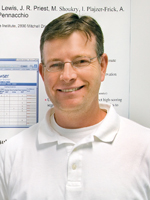 Pennacchio
Pennacchio
Specifically, Pennacchio’s team studied 58 genes in 379 obese and 378 lean people from Ottawa, Canada. These genes — a small fraction of a human’s 25,000 genes — were chosen because evidence suggests they may be involved in processes that regulate body weight, such as appetite. Half the people in the study group were fatter than 95 percent of the general population. The other half were thinner than 90 percent of the population.
“We observed that the obese subjects had twice as many rare gene variants that alter the predicted protein sequence compared to the lean subjects,” says Pennacchio, a geneticist with Berkeley Lab’s Genomics Division and head of the Joint Genome Institute’s (JGI) Genetic Analysis program. “This suggests a link between such changes and weight status.”
The team focused on the extreme ends of the population spectrum because they are likely to be enriched with whatever genetic quirks contribute to obesity and thinness. By comparing the two groups, the rare but important variants that promote obesity should stand out — if they exist.
This needle-in-a-haystack search is made possible by an innovative genetic sleuthing technique called resequencing, a tool geneticists use to search for gene mutations that may influence an organism’s traits. Scientists have long used this method to research single gene disorders, such as cystic fibrosis. Now, with the development of a whole human genome reference sequence, and with decreasing sequencing costs, the technique has been scaled up at the JGI to help scientists understand more complex and common conditions such as obesity.
Using this approach, the team read the sequences of all 58 genes from each of the 757 study participants, then analyzed the data for telltale differences among individuals. They found 1,074 genetic variants, with most of these variants so rare that they were found in less than one percent of the participants.
They also found twice as many rare variants in the obese group compared to the lean group. Although this is more than expected by chance, Pennacchio adds that they haven’t proved anything. The results only suggest that rare variants potentially contribute to increased weight. In addition, the team did not find that the same rare variants perfectly tracked with weight status in families, which is another indication of obesity’s complex underpinnings.
“Our argument is that these variants do have some effects, but the effects are relatively small, and they don’t on their own cause obesity,” says Pennacchio. “In other words, these variants are enriched in the obese population compared to the lean, but it is only a part of the puzzle. It is likely that these susceptibility variants work in concert with other genomic variants to determine an overall body weight metabolism, with some variants pulling the weight teeter-totter toward lean and other variants toward obesity.”
This work also helps pave the way for unrelated but equally important research. Specifically, JGI’s resequencing pipeline is being applied to bioenergy research. Scientists are using the technique to understand the genetic makeup of poplar trees, with the goal of possibly optimizing these trees for use as an efficient feedstock for ethanol production. Equipped with a poplar genome reference sequence, JGI scientists can work to determine what genes contribute to favorable traits such as fast growth and disease resistance, and then select these genes to improve biofuel feedstocks.
“This obesity research is a proof of principle. We can apply the same paradigm to search for interesting genetic variants in the poplar or other plant-based biofuels,” says Pennacchio.
Berkeley Lab Science Roundup
Gene and Variations
Gene mutations that contribute to health or disease aren’t always simple. In a pioneering study, a team including Len Pennachio of the Genomics Division, led by medical researchers from the University of Texas, identified numerous variations in a single gene within a group of people — a technique called “resequencing” — and related these to the occurrence of disease within the sample. Among 3,551 individuals, those with the lowest triglyceride levels and reduced risk of heart disease showed thirteen different sequence variations of the gene ANGPTL4, which regulates lipid and glucose metabolism. Two sequence differences marked those with highest levels and high risks. The study appeared in the April issue of Nature Genetics.
Nanoscale Cables Seek the Sun
 A cross-section of one version of a nanoscale coaxial cable, in which nitrogen, phosphorus, and gallium atoms are shown in blue, yellow, and magenta, respectively. (White represents hydrogen atoms, which help render the surface of the wire chemically non-reactive.)
A cross-section of one version of a nanoscale coaxial cable, in which nitrogen, phosphorus, and gallium atoms are shown in blue, yellow, and magenta, respectively. (White represents hydrogen atoms, which help render the surface of the wire chemically non-reactive.)
Light hitting a doped semiconductor excites negatively charged electrons and positively charged holes, which move to create an electrical current. In conventional semiconductors the electrons and holes stay close together and soon recombine. Better charge separation would improve the efficiency of many applications, including solar cells. Now a team of researchers from the National Renewable Energy Laboratory and Berkeley Lab, including Lin-Wang Wang of the Computational Research Division, has devised a nanoscale “coaxial cable” of gallium nitride and gallium phosphide, one wrapped around the other, with good charge separation and a band gap tailored for solar cells. Many other applications are possible, from quantum computing to nanoelectronics. The work appeared in the April 5 Nano Letters.
Lost in the Twilight Zone
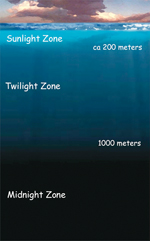 The VERTIGO experiment measured particulate carbon in the ocean’s twilight zone. Most carbon does not pass through the twilight zone but is recycled by oganisms.
The VERTIGO experiment measured particulate carbon in the ocean’s twilight zone. Most carbon does not pass through the twilight zone but is recycled by oganisms.
Phytoplankton near the ocean surface absorbs carbon dioxide from the atmosphere; carbon is sequestered when organic particles sink. But the ocean’s ability to store atmospheric carbon is more limited than scientists had hoped. A team of oceanographers including Jim Bishop of the Earth Sciences Division, led by researchers from the Woods Hole Oceanographic Institution, has shown that most particles never make it through the kilometer-deep “twilight zone” but instead are recycled by animals and bacteria. Near Hawaii, only 20 percent get through. However, says Bishop, “the biological carbon pump of the northwest Pacific is stronger and more efficient,” and 50 percent get through. Bishop suspects increased subsurface iron stimulates greater planktonic activity.
The Secret Life of Planktons
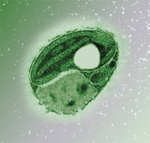 Phytoplankton of the genus Ostreococcus are ancient and measure a mere millionth of a meter in diameter.
Phytoplankton of the genus Ostreococcus are ancient and measure a mere millionth of a meter in diameter.
The phytoplankton that prime the ocean’s biological pump date back at least 1.5 billion years long, to the origin of all green plants — at least that’s the case for a unique algae recently analyzed at the Joint Genome Institute by Igor Grigoriev, Andrea Aerts, Jane Grimwood, Jeremy Schmutz, Asaf Salamov, Nicholas Putnam, Kemin Zhou, Robert Otillar, Gregory Werner, Inna Dubchak, and Daniel Rokhsar, with colleagues including Scripps Institution of Oceanography’s Brian Palenik. Species of tiny Ostreococcus, only a micron in diameter, contribute nearly half the world’s total phytoplankton activity. Their unique genome features include horizontally transferred genes that aid adaptation to different niches, and genes for selenium-rich proteins that reduce dependence on iron. The analysis is in the May 1 Proceedings of the National Academy of Sciences.
Tiny Nozzles
 The five nanonozzles in this image were etched from silicon. They measure only 10 by 12 millionths of a meter.
The five nanonozzles in this image were etched from silicon. They measure only 10 by 12 millionths of a meter.
Proteomics, the often painstaking study of the structure of nature’s hundreds of thousands of proteins, will be made much easier by a nanogadget developed by Daojing Wang of the Life Sciences Division (LSD), Peidong Yang of the Materials Science Division (MSD), with MSD’s Woong Kim and LSD’s Mingquan Guo, who published their techniques online in the April 20 Analytical Chemistry. The new device, catchily described as a “multinozzle nanoelectrospray emitter array,” combines mass spectrometry with microfluidic technology, etching arrays of nanoscale silicon nozzles for sensitive, stable detection of peptides and proteins. The simple and versatile fabrication technique will soon be extended to create a fully integrated analysis system for proteomics and could be used to fabricate other complex bioanalytical tools.
High Pressure Tactics
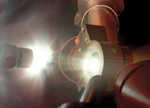 By first compressing materials in a diamond anvil, then vaporizing one of the diamonds with a powerful laser, pressures like those in the cores of giant planets can be obtained in the laboratory.
By first compressing materials in a diamond anvil, then vaporizing one of the diamonds with a powerful laser, pressures like those in the cores of giant planets can be obtained in the laboratory.
Twenty-five years ago Raymond Jeanloz, UC Berkeley professor of astronomy and a guest at the Advanced Light Source, developed the diamond-anvil cell, which can squeeze tiny amounts of material to five million atmospheres of pressure. Because diamonds are transparent, the materials can be heated with a laser beam. In the May 9 Proceedings of the National Academy of Sciences, Jeanloz and his colleagues at Livermore Lab, New Mexico State University, and the French Atomic Energy Commission report using a powerful laser not just to heat but to increase pressure to tens of millions and potentially billions of atmospheres — by vaporizing one of the anvil diamonds and sending its shockwave through the material. Jeanloz says the method will be useful for examining conditions in the cores of giant planets astronomers have discovered around other stars.
Keep On Truckin’

A study of over 6,119 male and 2,221 female runners over a seven-year period showed that those who ran over 30 miles per week gained only half the weight of those who ran less than 15 miles per week. Keeping up exercise with age was particularly effective in preventing extreme weight gain, which is associated with high blood pressure, high cholesterol, Type 2 diabetes, and other diseases. While many studies have tracked exercise over time, the exercise habits of the people in those studies may have changed considerably. This is the first time the type and amount of exercise — running — have been controlled over a long period, according to Paul Williams of the Life Sciences Division, who published these latest results of the National Runners’ Health Study in the May 3 Medicine and Science in Sports and Exercise.
Fleming is Elected To Science Academy
Berkeley Lab Deputy Director Graham Fleming is one of 72 new members of the prestigious National Academy of Sciences announced May 1) in Washington, D.C. Members are chosen “in recognition of their distinguished and continuing achievements in original research,” according to the academy.
Fleming is widely considered to be one of the world’s foremost authorities on ultrafast interactions among the molecules in liquids, solids and solutions. Using femtosecond lasers that flash a million billion times a second, he is able obtain stop-action images of the individual steps in a chemical reaction, which help to explain the dynamics of these reactions.
One of his goals is to develop artificial photosynthesis that would provide the world with clean, efficient and sustainable energy. He was instrumental in developing a proposal by UC Berkeley, LBNL and the University of Illinois to research biofuels that was recently chosen by the major oil firm BP to receive $500 million over 10 years.
Fleming, who is the Melvin Calvin Distinguished Professor of Chemistry at UC Berkeley, also is director of the UC Berkeley branch of the California Institute for Quantitative Biomedical Research (QB3), one of four California Institutes for Science and Innovation created by the state of California in 2000.
The National Academy of Sciences is a private organization of scientists and engineers dedicated to the furtherance of science and its use for the general welfare. It was established in 1863 by a congressional act of incorporation signed by Abraham Lincoln that calls on the academy to act as an official adviser to the federal government, upon request, in any matter of science or technology.
The election of 72 new members and 18 foreign associates from 12 countries was held during the business session of the 144th annual meeting of the academy. The recent elections bring the total number of active members to 2,025.
AAAS, Waterman, and Microbiology Awards for Researchers
American Academy of Arts and Science


Alexis Bell, (left) with Berkeley Lab’s Chemical Sciences Division, and Saul Perlmutter, with the Physics Division, are among the 227 scholars, scientists, artists, civic, corporate and philanthropic leaders recently elected to the American Academy of Arts and Science. “Fellows are selected through a highly competitive process that recognizes individuals who have made preeminent contributions to their disciplines and to society at large,” says academy president Emilio Bizzi.
NSF Waterman Award

Lab materials scientist Peidong Yang received the 2007 Waterman Award from the National Science Foundation. He was honored for his pioneering research on "nanowires" or strings of atoms, that show promise in creating a range of high-tech devices, including tiny lasers, computer circuits, and biological sensors. The annual award is given to researchers no more than 35 years old or seven years beyond receiving a doctorate.
American Academy of Microbiology


Lab life scientist Adam Arkin (left) and Physical Biosciences Division Director Jay Keasling have been elected to the American Academy of Microbiology (AAM). They are among 54 newly elected fellows announced yesterday. The AAM is the honorific leadership group within the American Society for Microbiology. Fellows are elected annually using a peer-reviewed process, based on scientific achievements and contributions that have advanced microbiology.
‘Daughters, Sons’ Day Brings Nearly 100 Kids to the Lab
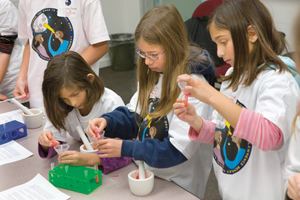 Youngsters conduct a DNA spooling experiment
Youngsters conduct a DNA spooling experiment
Lab employees brought nearly 100 children — sons, daughters, relatives and friends ages 9 to 16 — to the Lab on April 26 to learn about science as part of the annual "Daughters and Sons to Work Day." Teenagers attended workshops hosted by the Accelerator and Fusion Research, Earth Sciences, and Life Sciences Divisions, while the younger kids enjoyed a virtual visit to Mars and presentations on liquid nitrogen, structures and changes in matter, and DNA spooling. Career fairs for boys and girls were also held. The event was made possible by staff at the Lab's Center for Science and Engineering Education and these volunteers: Sharon Borglin, Christine Celata, Bill Fisher, Graham Fleming, Eleanor Lee, Bill Moses, Ina Reichel, Chip Smith, Cailyn Spurrell, Pat Thomas, Margaret Torn and Marty White.
People, Awards, and Honors
Radiation Protection Award for Lab Scientist

At the annual meeting of the National Council on Radiation Protection and Measurement (NCRP) in Arlington, VA, on April 16, Patricia Durbin of the Chemical Sciences Division was honored as the NCRP’s 31st Lauriston S. Taylor lecturer. Her lecture, “The Quest for Therapeutic Actinide Chelators,” concerned chemicals that sequester and remove from the body such elements as plutonium. Durbin was selected for the Taylor lectureship, the NCRP’s highest award, for her scientific contributions to the field of actinide chemistry and biology, her commitment to radiation protection, and her 50 years of service to the NCRP.
Heat Island Group Gets Energy Efficiency Award



The Environmental Energy Technologies Division’s Heat Island Group has won a 2007 “Flex Your Power” award in the Innovative Products category for the development of Cool Color Roofing materials. The project team, Hashem Akbari (left), Paul Berdahl (center) and Ronnen Levinson, worked with private firms representing the majority of U.S. roofing products to develop energy-efficient roofing that can reduce air conditioning energy use by 10 to 20 percent. “Flex Your Power” award winners have saved more than $172 million, one billion kilowatt hours and reduced greenhouse gas emissions equivalent to removing 80,000 cars from the road.
Chemical Scientist Wins Dissertation Award
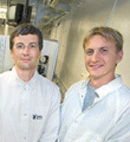
The American Physical Society’s Division of Beam Physics (APS-DBP) has announced that Jeroen van Tilborg (right), currently in the Chemical Sciences Division, has won the APS-DBP’s annual Award for Outstanding Doctoral Thesis in Beam Physics for his dissertation. His publication describes the detection, characterization, and imaging of coherent terahertz radiation from laser-wakefield-accelerated electron beams. Van Tilborg did his thesis work as a graduate student in Wim Leemans’ LOASIS group in AFRD. He was also advised by Marnix van der Wiel of the Technical University Eindhoven (the Netherlands), the institution which awarded his Ph.D.
Materials Sciences Grad Student Receives Honor

Berkeley Lab Materials Sciences Division graduate student James Wilcox recently received the Daniel Cubicciotti Award from the Electrochemical Society’s San Francisco chapter. The award was established in 1994 to assist a deserving student in Northern California to pursue a career in the physical sciences or engineering. Wilcox will receive a plaque and $2,000 for educational assistance. Wilcox’s advisors are Lut DeJonghe and Marca Doeff, both with Materials Sciences.